Planning your 2026 adventures? Discover the top 10 destinations around the world, from Tanzania’s wild safaris to Hong Kong’s green urban escapes, for unforgettable experiences.
As 2026 approaches, it’s time to fuel your wanderlust and start dreaming big. The world is bursting with incredible destinations that promise adventure, culture, and once-in-a-lifetime experiences. Condé Nast Traveler’s latest list of the best places to go in 2026 celebrates locations that are pushing boundaries—whether through new experiences, cultural revitalisation, or untouched natural beauty.
From tropical islands to mountain escapes, bustling cities to secluded rainforests, these destinations are perfect for travellers craving something extraordinary. Here’s a closer look at where your next journey could take you:
1. Arusha, Tanzania | Arusha is redefining safari experiences in 2026. Beyond the traditional wildlife encounters, the city is welcoming a beloved icon and unveiling a new forest safari camp that promises intimate encounters with nature. Imagine waking up to the sounds of the jungle, enjoying a luxury lodge breakfast, and heading out for a guided trek among Africa’s iconic wildlife. Arusha is where adventure meets elegance.
2. East Coast, Barbados | If you’ve been dreaming of the ultimate island escape, the East Coast of Barbados offers unspoiled beaches, hidden coves, and authentic local culture. With more access than ever, travellers can explore untouched fishing villages, enjoy fresh Caribbean cuisine, and bask in turquoise waters without the usual crowds. It’s paradise, upgraded.
3. Brussels, Belgium | Brussels is on a creative comeback, buzzing with energy in art, music, and cuisine. From hidden galleries to vibrant street murals and Michelin-star restaurants, the city offers endless inspiration for culture lovers. Wander through cobblestone streets, sip artisanal coffee in eclectic cafés, and discover a city that is blending its rich history with a fresh modern vibe.
4. Chiriquí Province, Panama | Chiriquí is where castaway dreams come alive. With pristine marine reserves, eco-resorts, and a strong focus on sustainability, it’s the perfect spot for those who love adventure with a conscience. Snorkel among colourful reefs, kayak through quiet rivers, or simply relax in nature’s tranquillity. It’s Panama at its most untouched and magical.
5. Deer Valley, Utah, USA | Deer Valley continues to charm snow lovers and adventure seekers alike. With double the skiable terrain and one last (Sun)dance festival to enjoy, this mountain town blends thrill with luxury. Picture yourself skiing through pristine slopes, sipping hot chocolate by a roaring fire, and immersing in the vibrant arts and festival scene. Winter magic, reimagined.
6. Fès, Morocco | Fès is undergoing a stunning renaissance. Ambitious restoration projects are breathing new life into this ancient city, making it a feast for the senses. Explore colourful souks, admire centuries-old architecture, and lose yourself in a maze of historic streets where modern cafés and artisan workshops bring history to life. A journey to Fès is a journey through time.
7. Gabon, Central Africa | For travellers who crave true isolation and raw natural beauty, Gabon is a revelation. Rainforests meet the Atlantic coast, offering immersive alternatives to typical safari experiences. From trekking through pristine jungles to spotting rare wildlife along the shore, Gabon is adventure at its purest. Expect awe, wonder, and unforgettable encounters with nature.
8. Upper Carniola (Gorenjska), Slovenia | Slovenia’s Upper Carniola region is straight out of a fairy tale. Picture emerald lakes, misty mountains, and charming villages where tradition thrives. It’s perfect for travellers seeking scenic hikes, peaceful lakeside strolls, and cosy local inns. Each corner of Gorenjska tells a story, inviting you to slow down and savour the magic of Europe’s hidden gem.
9. Guadalajara, Mexico | Guadalajara pulses with life in 2026. Known for its world-renowned festivals and the FIFA World Cup excitement, it’s also a hub of female-led creative industries. Dance through colourful streets, taste vibrant local cuisine, and join in the celebrations that make this city a cultural powerhouse. Guadalajara is where tradition meets modern energy.
10. Hong Kong, China | Hong Kong continues to evolve, with expanded green spaces and breathtaking city panoramas. Explore bustling markets, hike scenic trails above the skyline, and unwind in serene urban parks. The city offers the perfect mix of cosmopolitan excitement and natural tranquillity—an urban jungle that never stops surprising.
2026 is shaping up to be the year of discovery. Whether it’s wandering the historic streets of Morocco, chasing sunsets in Barbados, or venturing deep into Gabon’s wilderness, these ten destinations promise to awaken your sense of wonder.
Start planning, pack your bags, and let the world surprise you. Adventure, culture, and nature await—are you ready to explore?



